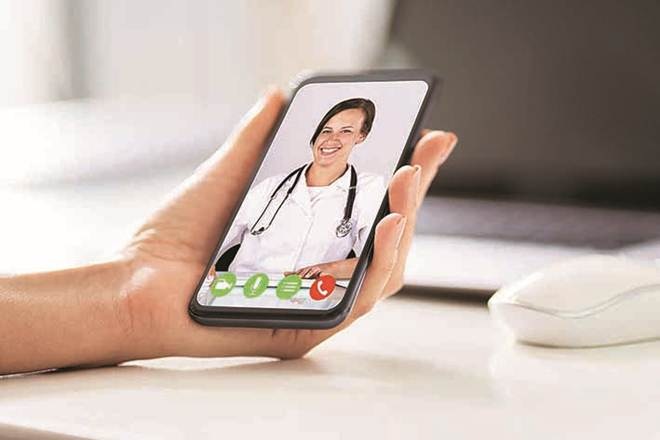Telemedicine is seeing an increased focus, and the government is committed to supporting its spread. Dr Ganapathy Krishnan, the Chennai-based neurosurgeon and a pioneer in telemedicine who has been promoting the idea for over 20 years, says, “It is a matter of great satisfaction that, after several years of persistence, the Telemedicine Society of India’s (TSI) efforts to have official guidelines passed for the practice of telemedicine in India have borne fruit.” It may not have happened, but for the Covid-19 outbreak. A remotely administered practice of consultation will help stop overcrowding of hospitals during a pandemic.
The government has recently cleared several legal issues relating to telemedicine, including medical licences. “We were getting demands from the digital health industry to release the guidelines. Due to the coronavirus pandemic, the process got expedited, which would have otherwise taken longer,” says Alok Kumar, adviser (health) at the NITI Aayog. Covid-19 took four weeks to convince the government, while the TSI has been at it for four years.
India has a shortage of healthcare facilities and an inadequate health infrastructure. Under these circumstances, how can telemedicine help contain the coronavirus pandemic? Dr Ganapathy adds, “It is a safety valve for a strained healthcare system. Telemedicine is a term encompassing methods used to examine, investigate, monitor and treat, with the patient and doctor located in different places. Unnecessary travelling is eliminated. Image acquisition, storage, display, processing and transfer form the basis of telemedicine.
Managing a pandemic also requires keeping sick people out of hospitals. ‘Virtual visits’ can be an effective way to decide who needs testing. Telehealth provides remote consultation for normal health issues that will affect 5-10% of the quarantined population. Covid-19 suspected patients mustn’t be routinely referred to casualties or OPD services in the hospitals to minimise the risk of exposure to other patients and healthcare providers. With telemedicine, a single remote clinician can cover multiple sites spread over different geographies.
Telemedicine can work in ICU management as well. Dr Sai Praveen Haranath, a senior consultant pulmonologist and critical care specialist, says that remote intensive care is a saviour for India. “We began the eACCESS (Apollo Critical Care and Emergency) to manage critically-ill patients. Located in our centre in Hyderabad, we are connected to centres across India. Most of these locations are in rural and forest areas. We guide patients in ICU, to safely transport to the next higher level of care or manage locally. We can guide ventilator use as well as advice on irregular heart rhythms on a real-time basis.”
Makeshift improvised emergency ICUs are unlikely to have qualified doctors. Thus, handholding and telementoring are essential. An existing ICU should act as a central command station connected to new ICUs. It will make all the difference, adds Dr Ganapathy, a former president TSI, former president of the Neurological Society of India, and director, Apollo Telemedicine Foundation & Apollo Telehealth Services.
“It was 20 years ago that US president Bill Clinton, during his state visit to India, formally commissioned the world’s first VSAT-enabled village hospital at Aragonda, Andhra Pradesh. In 1998, I had been introduced to the term ‘telemedicine’ while delivering a lecture at IIT Kanpur, and got hooked to the idea,” he adds. It took Dr Ganapathy a few years to learn about it, and he was convinced that this is essential for India.
With Apollo Hospitals founder Dr Prathap C Reddy’s support, Dr Ganapathy launched Apollo’s telemedicine operations in 2000. “During the last 20 years, there have been many difficulties in the deployment of telehealth. The very idea of providing health through ICT was alien to India. Those were the days of 2G communication, power-cuts and diesel generators. We did not let anything stop us,” he says.
Public-private partnerships in telehealth are now operational in many states. However, erroneous interpretation of some judgements in the media has ended up questioning the very legality of providing teleconsultations. All these hurdles have been crossed now. With great strides in technology and efforts by doctors, telemedicine is finally finding its right place in healthcare.
Fast-growing use also creates challenges. It takes time to establish the technology infrastructure, recruit virtual providers, provide training on best practices, and educate patients about telehealth through patient-facing websites, social media and direct outreach. Digital payment must be facilitated as well. Resources need to be mobilised to build infrastructure and capacity. To encourage patients to take up telehealth options, telehealth professionals should proactively and frequently provide information.
Today, Tamil Nadu accounts for 30% of consultations taking place in India. Eye hospitals Sankara Nethralaya and Aravind Eyecare, Madurai between them cover 6,000 consultations, and Apollo does 5,000, per day. TSI is commencing a massive pan-India three-hour online orientation session for all doctors free of cost. Almost all state governments, national healthcare institutions and hospitals in the private sector have started advocating telemedicine. “Geography will now become history,” says Dr Ganapathy.
sushila.ravindranath@expressindia.com

